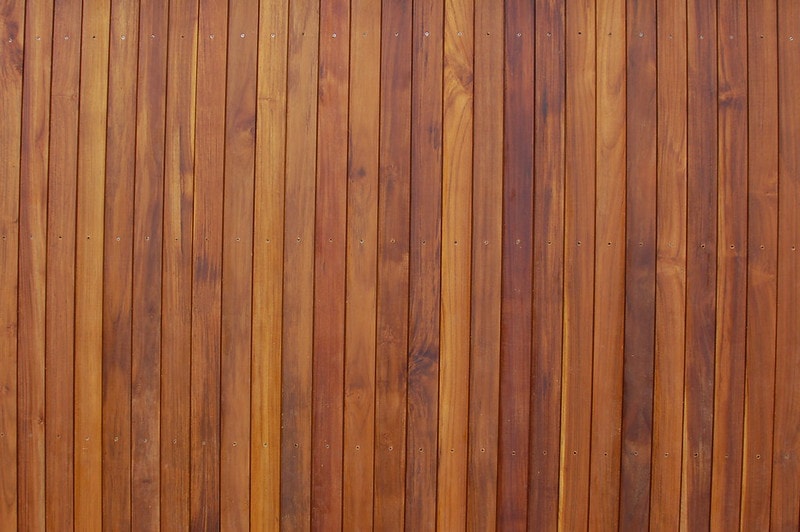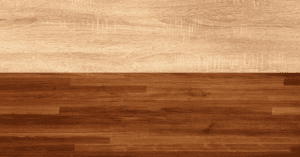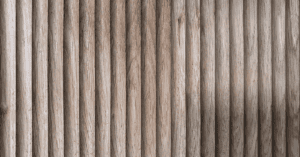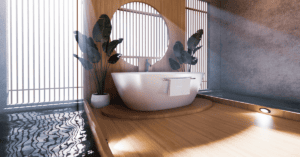
Have you fallen in love with a piece of teak furniture only to be shocked by the price tag? That makes two of us. As a homeowner, I know the struggle of searching for high-quality, reasonably priced furniture.
The main reason teak is expensive is because there is high demand and low supply. This hardwood is prized for its durability and weather-resistant properties and in many cases has to travel a long distance to reach end customers. Teak suppliers and furniture manufacturers cannot always keep up with the large market due to limited resources.
There are more reasons why teak has a high price tag. In this article, I will discuss the factors affecting teak wood furniture’s cost. I will also talk about why I ended up buying teak furniture despite its price. But if you have a limited budget, there are some cheaper wood alternatives listed below.
What Is Teak Wood?

Teak, also known as Tectona grandis, is a durable hardwood native to South and Southeast Asia countries.
Teak wood has high amounts of natural oils. It can withstand insects, moisture, sunlight exposure, and other harsh weather elements.
The teak trunk is also strong and dense. It boasts a Janka hardness rating between 1,070 and 2,330 lbf (pound-force). A higher figure means better resistance to decay, dents, and scratches. Genuine teak ranks above average in terms of hardness.
Plus, teak has an attractive golden brown color. This shade can enhance your living area.
All these features make teak a top choice for wood furniture. However, they also contribute to the hefty price tag of this tropical hardwood.
Pros of Teak Wood
You will enjoy many benefits when you choose teak wood for your furniture piece.
- Very durable material
- It is highly resistant to moisture, UV rays, and weathering
- It can stand against decay, dents, and stains
- Low maintenance hardwood
- It has many applications in and out of the home
- The golden brown color can beautify your living space
Cons of Teak Wood
You might want to consider the downsides of owning teak furniture before finalizing your purchasing decision.
- Expensive
- It is not the most sustainable hardwood because of some illegal logging practices
- The teak can fade into a silver-gray patina
Where Does Teak Wood Come From?
Teak wood comes from teak trees native to Asian countries, mainly India, Indonesia, Myanmar, and Thailand.
However, in the past century, natural teak forests suffered from unsustainable harvesting and illegal logging. They became nearly extinct several times throughout history. Some tree species also remain endangered today. So ensure to avoid these types of wood.
Fortunately, other countries in Africa and Central America cultivated and naturalized teak wood. Today, most teak products originate from these sustainable plantations.
How Expensive Is Teak Wood?
You may have heard about the hefty price of teak wood. But how expensive is this hardwood, exactly?
Teak wood costs between $10 and $40 per board foot. The exact price varies based on its origin country, quality, thickness, and the buyer’s location.
Grade A teak, which comes from heartwood, is the most expensive variety. It can cost up to $40 per board foot. A B-class teak is still a high-end option but considerably cheaper than heartwood. Finally, grade C teak harvested from the outer teak tree is the cheapest at less than $10. The only downside is the lack of natural protective oils, making it susceptible to damage and rot.
As for the price of teak furniture, it ranges from $150 to $2,000, and even higher. The cost can depend on several factors, which I will discuss in the next section of the article.
However, note that teak is expensive due to its more premium features than other woods. It is extremely durable and weather-resistant, thanks to its natural wood oil content. It also has a beautiful honey-brown color suitable for different applications.
Why Is Teak Wood Expensive?
Why is teak so expensive? There is doubt that teak is one of the most expensive woods today. However, you may be curious to know what affects the price of teak wood.
Let us delve into several reasons why genuine teak is so expensive.
High Competition
Teak is one of the most popular hardwood materials for furniture. There is a high demand for this wood type because of its natural protective qualities and beauty.
That results in plenty of competition among furniture manufacturers aiming to meet consumer needs. This demand for genuine teak increase can likely cause prices to rise.
Low Inventory
Although teak furniture is popular, manufacturers tend to have limited stocks on hand. The reason is the slow growth rate of teak. It takes around 20 to 25 years for most teak trees to become fully matured and ready for harvest. Unfortunately, we often take more hardwood than these trees can produce.
When teak furniture is low in supply but high in demand, its price significantly increases. It is the basic law of supply and demand.
Exchange Rate
Teak is native to South and Southeast Asia. But other teak producing countries also export mature teak wood to other nations worldwide. They collect tariffs or fees for every wood product they sell to manufacturers. In turn, these furniture makers increase the price of teak pieces before selling them to end consumers, which is us.
Transportation
Furniture manufacturers pay expensive shipping costs to transport teak pieces to customers. So regardless of where you are located, the price of transportation can affect the final teak cost.
Processing
Teak furniture pieces undergo complicated processing. That includes harvesting teak, milling, drying, sanding, and finishing the surface with oils or varnishes before usage. All these methods contribute to why teak is expensive.
Seasonality
The price of teak wood can rise and fall depending on the season. Certain periods experience an influx of orders from homeowners seeking to buy outdoor teak furniture. During this time, teak may be more expensive than usual.
Teak Wood Quality
The hardwood quality also affects the price of teak furniture.
As briefly mentioned earlier, grade A teak is the most expensive wood variety. It comes from the heart of mature teak trees. Hence, it has the largest concentration of natural oils that resist moisture and weathering elements.
Grade B teak is durable and hard-wearing enough to withstand outdoor use. However, it derives from the outer heartwood section. That means it has less pure oil content and a duller appearance than grade A teak furniture.
C-class teak furniture is the cheapest, but it also decays the quickest. It refers to the outer sections of immature teak trees. It contains little to no protective oils, making it susceptible to stains, scratches, and rot.
Teak Variety
Teak is available in different types or species. Thus, some teak pieces are more expensive than others.
For instance, mature or old teak from natural forests charges more for their wood. On the other hand, other woods derived from teak plantations have a lower price.
Is Teak Worth The Price?
By now, you are already aware of the factors determining the price of teak furniture. You may ask yourself whether teak is worth buying or not.
There is no right or wrong answer. It depends on your needs and preferences.
If you seek high-quality furniture that can last for several years, genuine teak is the way to go. While it is more expensive than other wood types, it offers features that are hard to beat. These include natural weather resistance, hardness, minimal maintenance, and a classic look. Overall, teak outdoor furniture can be a worthy investment for homeowners who want to enhance their living spaces.
That said, some species such as Burmese teak and Indian teak are not the most sustainable hardwoods. They can also age and fade into a silver-gray patina over time. Consider these downsides before finalizing your purchasing decision.
Will Teak Increase Price in the Future?
It is difficult to predict the price of real teak because various factors are involved. However, the teak cost may reduce over time for several reasons.
First, teak furniture is currently overpriced. The steep cost is not sustainable in the future, so it will likely decrease.
More furniture manufacturers may also start producing teak as demand increases. As the supply or stocks of the teak surge, it can lead to a price drop.
Several users who want to buy teak but are discouraged by the price might start exploring cheaper wood alternatives. When more homeowners discover these other materials, the demand for teak can decrease. In turn, it reduces the cost of teak outdoor furniture.
What Are Cheaper Alternatives to Teak Wood?
Though there are various grades of teak wood, they are still subject to the demands of the market. Here are some woods that have the same look and feel as teak. Most of them, though, do not compare in terms of durability and hardness.
Similar to teak, acacia wood is a popular material for outdoor furniture. It costs around $7 to $10 per board foot. However, it requires frequent maintenance and protective treatment to last for several years.
Bamboo is another teak alternative to consider. Technically, bamboo is a grass that undergoes processing. It grows faster than teak, which makes it readily available on the market. It is also significantly cheaper. The only downside is that it cannot withstand outdoor use.
Conclusion
Most of us want to enhance our living spaces with beautiful wooden furniture like teak. Teak is expensive because of the high-quality features that make it popular.
Unfortunately, manufacturers can barely keep up with consumer demand. Of course, other factors also affect the cost of teak, as explained above.
Teak wood furniture is definitely worth purchasing if you seek a very durable yet low-maintenance material. There are some cheaper options, but purchasing teak will likely save you in the long run.
If you find this article helpful, let us know!






